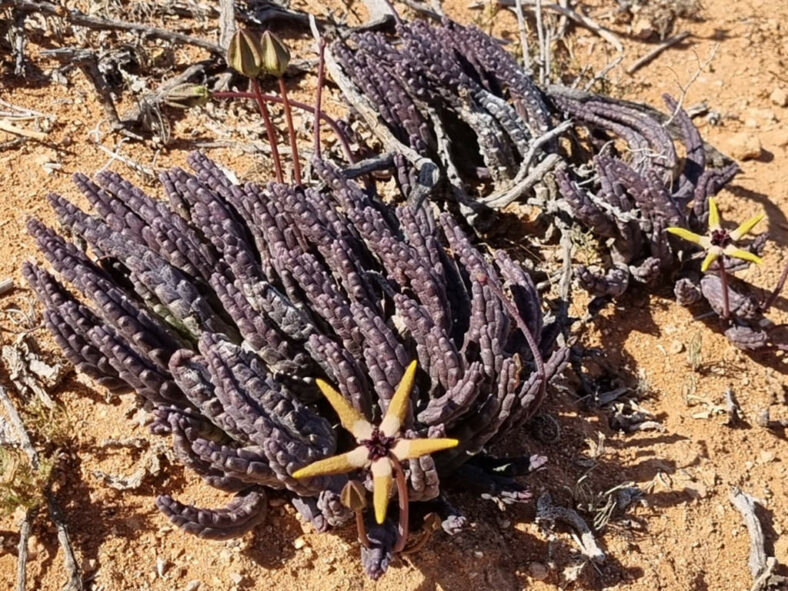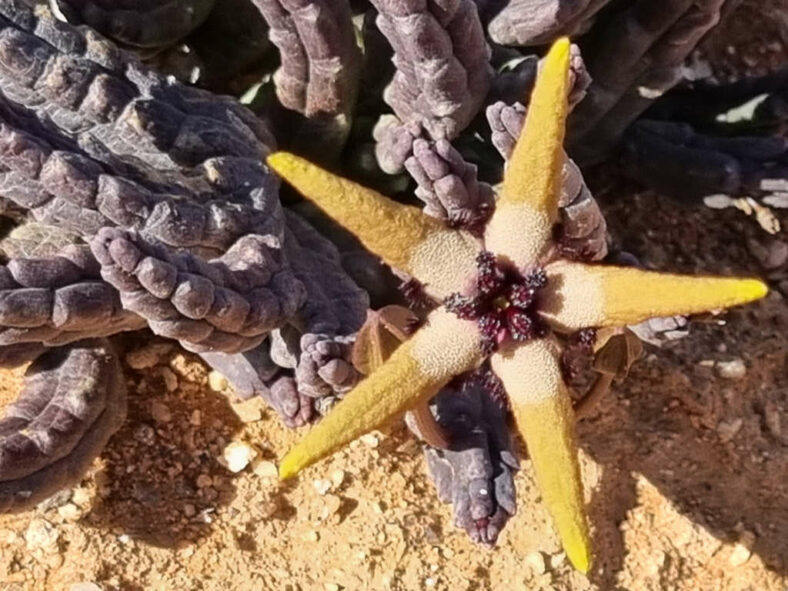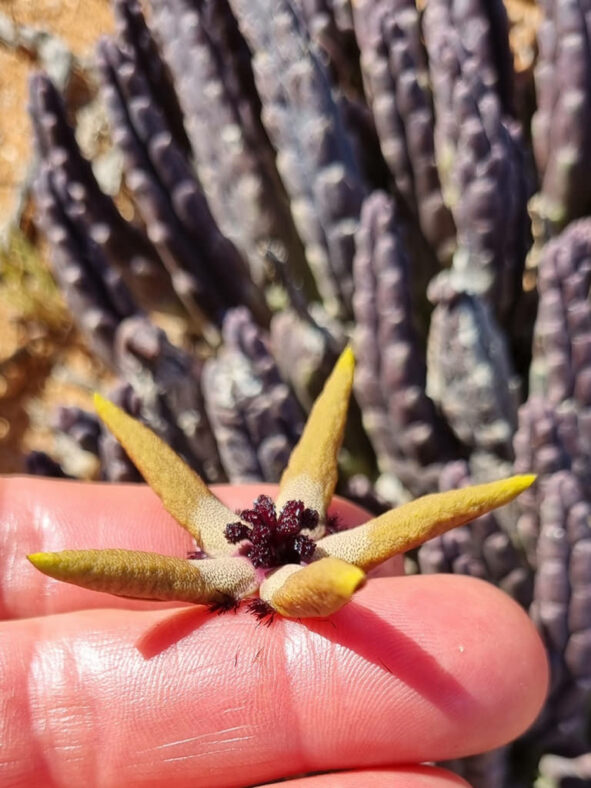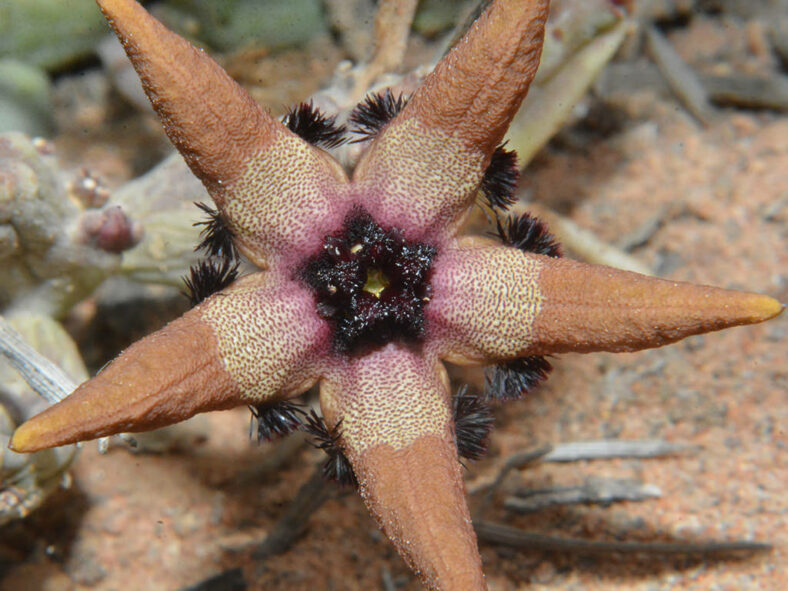Tromotriche pedunculata is a clump-forming succulent that is easy to grow and has striking star-shaped flowers.
Scientific Name
Tromotriche pedunculata (Masson) Bruyns
Synonym(s)
Caruncularia pedunculata, Ceropegia penduliflora, Stapelia pedunculata, Stisseria pedunculata, Tridentea pedunculata
Scientific Classification
Family: Apocynaceae
Subfamily: Asclepiadoideae
Tribe: Ceropegieae
Subtribe: Stapeliinae
Genus: Tromotriche
Etymology
The specific epithet "pedunculata" (pronounced "ped-un-kew-LAH-tuh") means "having a pedicel; pedunculate" and refers to the long flower stalks of this species.
Origin
The native range of Tromotriche pedunculata extends from Witputz in Namibia, throughout Namaqualand south to Vanrhynsdorp in the Western Cape province of South Africa, and sporadically further southwards to Touwsrivier.
Description
Tromotriche pedunculata is a succulent plant that forms clumps of upright to nearly prostrate stems with ascending tips. The stems are pale green to reddish and can grow up to 4 inches (10 cm) long and 0.6 inches (1.5 cm) thick, tapering slightly towards the tip. The tubercles are very obscure, so the stem is obtusely 4-angled to almost cylindrical, without an apical tooth.
During the spring, Tromotriche pedunculata produces one or two inflorescences per stem, each with one to two star-shaped flowers. The inflorescences arise mainly towards the base of the stem on stalks that can measure up to 0.4 inches (4 cm) long. The flowers are attached to the inflorescence by upright to spreading stalks that can grow up to 7.6 inches (19 cm) long.
The corolla is deeply lobed and can reach a diameter of up to 2.8 inches (7 cm). Outside, the corolla is pale green with darker, slightly impressed veins. Inside, it is olive-green or yellow-brown to maroon on the upper two-thirds of lobes, below this whitish, finely flecked with maroon, becoming darker towards the center. The narrow lobes are fringed with a dense beard of dark cilia towards the base. The corona is mostly shiny, purplish black, raised on a short, very stout stipe, measuring up to 0.3 inches (0.7 cm) tall and 0.45 inches (1.1 cm) broad.

How to Grow and Care for Tromotriche pedunculata
Light: Tromotriche pedunculata prefers full sun but will benefit from light shade during the hottest summer days. Indoors, place the plant near the brightest window of your home because it will stretch if it does not receive enough sunlight. Avoid abruptly moving a plant adapted to lower light levels to full sun to prevent sunburn.
Soil: Use commercial potting soil mix for succulents or prepare your own with 50 to 70 % mineral grit, such as coarse sand, pumice, or perlite.
Temperature: The plant thrives in warm outdoor environments with low to moderate humidity. It does not like winter cold and should remain fairly dry and warm during its dormancy. Tromotriche pedunculata grows best in USDA Plant Hardiness Zones 11a to 11b, with average minimum winter temperatures ranging from 40 to 50 °F (4.4 to 10 °C).
Watering: It has typical watering needs for a succulent. During the growing season, from spring to fall, water the plant thoroughly and allow the soil to dry between waterings. When it goes dormant in winter, it needs almost no water, about once a month.
Fertilizing: Feeding is a good idea to keep the plant healthy and promote growth. Use water-soluble fertilizer diluted to half the recommended strength, but only when the plant is actively growing.
Repotting: Repot Tromotriche pedunculata in spring, just before the growing season. It has shallow roots and does not require too much soil to grow. Always pick a container with drainage holes.
Propagation: The best way to propagate this succulent is by stem cuttings. To ensure good rooting, take cuttings during the growing season. The plant is also easy to start from seeds in spring.
Learn more at How to Grow and Care for Stapeliads.
Toxicity of Tromotriche pedunculata
Tromotriche pedunculata has no toxic effects reported, so it is safe for growing around kids and pets.
Varieties
Links
- Back to genus Tromotriche
- Succupedia: Browse succulents by Scientific Name, Common Name, Genus, Family, USDA Hardiness Zone, Origin, or cacti by Genus
Photo Gallery
Click on a photo to see a larger version.


